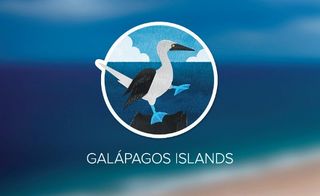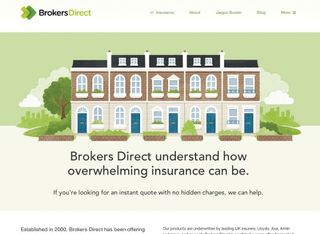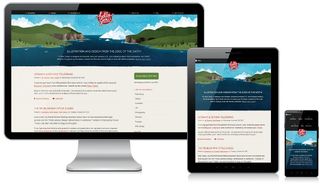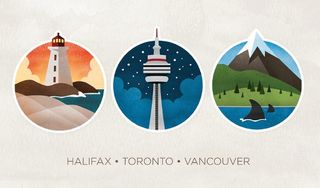Geri Coady on creative freelancing and public speaking
Working with watercolours, vectors and cameras makes Geri Coady very happy. Martin Cooper finds out why.
If you're looking for proof of Geri Coady's boundless enthusiasm for the business of creativity, we'd like to present the size of the Dropbox file she sent to accompany the piece you're reading. It weighed in at 172MB, or at least 10 times the average submission. We set about uncovering how she started on the web, what motivates her and why she quit her job as an art director for the life of a freelance creative.
Why don't you introduce yourself?
I'm Geri Coady - a freelance web designer and illustrator from St. John's, Newfoundland, Canada. Nobody knows where that is, so I usually describe it as being the most easterly city in North America, or where the Titanic sank.
When did the web first make an appearance in your life?
I used the internet for the first time in 1995, but I didn't get a home PC until 1998. One of the first things I did was to learn how to make a website. I used Netscape Composer and another editor called HotDog, and I made a fan page for No Doubt that I couldn't figure out how to actually put on the internet.

Do you think it's tougher to make a start in the web industry today?
Things seemed somehow simpler in the days of Lycos and AltaVista. Maybe it's just because I was young at the time, but I found it incredibly confusing to make a website back then. I had no one to ask for help. At the same time, expectations of a website were pretty low; throw a few 'Under construction' GIFs up there and you were good to go.
These days, designers have endless resources and support from peers, but everything is much more complicated. The bar is set really high to design something that's going to blow everyone's minds, but still be accessible, responsive, and have a tiny page weight. Fortunately, I think most of us are up to that challenge!
And what about design: how did you start on that path and follow it?
My high school art teacher tried to twist my arm into going to art school and was really disappointed when I told her I was going to do graphic design instead. I think she was one of those people who felt that university was the only path for a student. I couldn't disagree more.
After three years in college for design and printing, I landed a job at a local company that specialised in e-learning software. After that, I moved on to an advertising agency. It offered the full deal for clients - radio, TV, print and web - so I focused more on print and web and worked my way up to art director level.
Ever tempted by web development?
Before I graduated high school, I had actually submitted an application to do a two-year software programming course. I'm not sure why because I was terrible at math and numbers. I was probably thinking 'which job is going to make me more money?' instead of 'which job am I going to enjoy?' When I realised what I'd done, I called up and asked them to switch my application to design instead!
I'm happier these days knowing that I need to focus my energy on things I actually enjoy. It's easier to accept my weaknesses and collaborate with people who have the skills to balance mine.

You quit your job as an art director? Looking back on that decisions and its ramifications, how do you feel?
Honestly, I couldn't be happier. I spent a couple of years thinking about freelance, but didn't feel like I was ready. Then, one inspiring talk at the New Adventures conference drove me to write my resignation letter and quit as soon as I got home. I loved the people I worked with, but it was time for me to move on.
What would you say to that freshly unemployed Geri?
Nothing. I knew I was making the right choice, no matter what happened in the future. I'd send her a cake instead.
What's the secret to finding work as a freelancer?
I try to make as many connections with other designers as possible. I love meeting people at conferences, whether I'm speaking or not. I find writing helps a lot, too. Sharing your thoughts and helping others opens up all kinds of doors. I'd also say that more than half of my work enquiries these days come to me through my Dribbble profile.

You describe yourself as an illustrator, designer and photographer. Do you have a preference?
I really love all the illustration I'm doing these days, but ideally I prefer any opportunity that allows me to use illustration and design together. I once thought about pursuing photography as a profession, but I think I enjoy it more as a hobby, and I'll only do select jobs if the opportunity comes up!
Is there a common theme that runs through your creative output?
Over the years I've spent a lot of time practicing different styles because I wanted to be versatile, but lately I've been trying to explore a style I can call my own. I'm doing more vector-watercolour work these days, which is a big part of my new website and is used for a few bigger client projects.
You've written a book too?
It's A Pocket Guide to Colour Accessibility, published by Five Simple Steps. For the price of a cup of coffee, you can learn everything about designing for people with colour-blindness.

As a creative, what do you carry around with you?
If I'm travelling, I always carry a sketchbook, my iPad, DSLR, Instax camera, Macbook Pro and a Wacom Intuos tablet. If I'm just out around town, my iPad's the only thing I need!
What are the essential tools and apps you use that keep you running like a Swiss watch?
I couldn't live without Adobe Illustrator. I even use it for mocking up websites. I like it because it doesn't have as many bells and whistles that could encourage designing the entire website and then waste time doing it again in the browser. Illustrator allows me to do just enough to get a feel for the design, then jump into code and do the polishing later. Other apps in my toolkit include Photoshop, TextWrangler, Color Oracle, Evernote, InDesign and, of course, Rdio.
When it comes to beginning a project, do you sketch, hit Photoshop or maybe start thinking about colour first?
I sketch everything on paper first to get a good idea if it's going to translate well to the screen. When I'm ready, I'll paste sketches into Illustrator and go from there.
I tend to design without colour first. I certainly think about it from the beginning and I set palette ideas aside, but I like to design the page concept in greyscale. If I can achieve good contrast and balance there, I know that there'll be a better chance of my design looking good to someone with a visual impairment, and introducing the palette into my design is a little easier.
Why is speaking so important?
I think everyone has something to share that others can learn from. I've often heard people say that others aren't "qualified" to speak, which is ridiculous. Even a new speaker will likely be able to share a viewpoint or experience that will benefit someone else.
If you know you'd like to share your thoughts but feel you aren't ready for a big stage, why not volunteer or offer to speak to a college class, or even a younger group of students? Everyone wins. I had no public speaking experience before doing my first web talk except for teaching basic web design to kids, and it really did help.

What about mentoring? Do you think web workers have a responsibility to the next generation?
Absolutely, especially when everyone's expected to be able to do it all. In my experience, even the most well-intentioned teachers aren't able to keep up to date on everything in the industry. Many are working from an outdated curriculum, too.
I recently mentored a programming graduate who wanted to learn more about HTML, CSS and PHP. After teaching him a few basic concepts and helping him through some projects, he said he wished he'd studied web design instead! That made me happy, but also sad that he felt like he'd missed out.
Which is worse: a parking ticket, a paper cut, or finding a double space in copy you're laying out?
A parking ticket and a paper cut would be completely my fault, but double spaces after a full stop will never be mine. Maybe that answers the question!
If the internet ended, would you still make and create?
I think I'd become a full-time baker. I love designing and baking cookies, and I imagine that I'd make some pretty fun cakes, too. A couple of years ago I made these Dribbble cookies that seemed to be a real hit!
Words: Martin Cooper
This article originally appeared in net magazine issue 249.
Liked this? Read these!
- The designer's guide to working from home
- Brilliant Wordpress tutorial selection
- Our favourite web fonts - and they don't cost a penny

Thank you for reading 5 articles this month* Join now for unlimited access
Enjoy your first month for just £1 / $1 / €1
*Read 5 free articles per month without a subscription

Join now for unlimited access
Try first month for just £1 / $1 / €1
Get the Creative Bloq Newsletter
Daily design news, reviews, how-tos and more, as picked by the editors.
The Creative Bloq team is made up of a group of design fans, and has changed and evolved since Creative Bloq began back in 2012. The current website team consists of eight full-time members of staff: Editor Georgia Coggan, Deputy Editor Rosie Hilder, Ecommerce Editor Beren Neale, Senior News Editor Daniel Piper, Editor, Digital Art and 3D Ian Dean, Tech Reviews Editor Erlingur Einarsson, Ecommerce Writer Beth Nicholls and Staff Writer Natalie Fear, as well as a roster of freelancers from around the world. The ImagineFX magazine team also pitch in, ensuring that content from leading digital art publication ImagineFX is represented on Creative Bloq.
